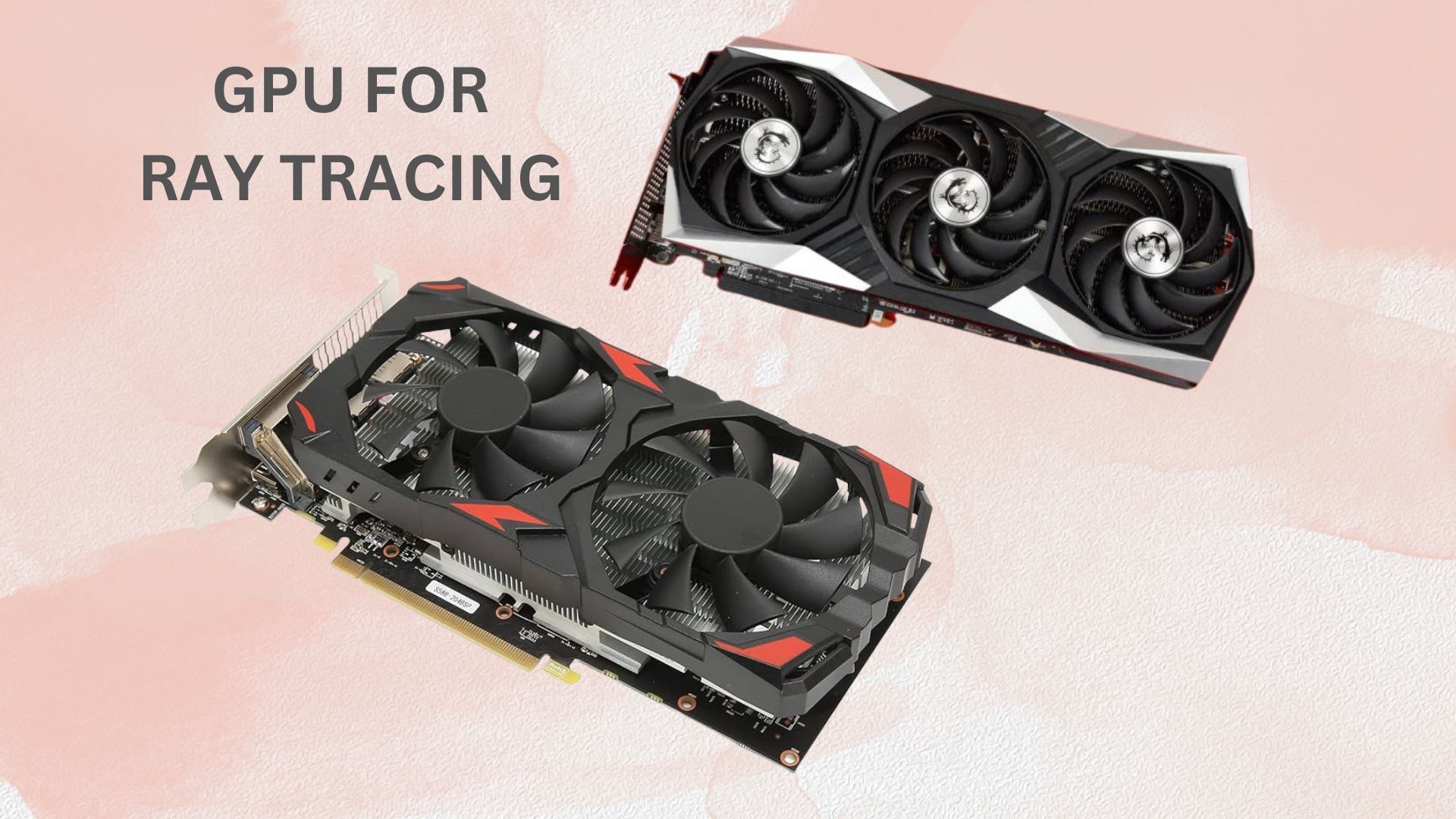Which GPUs Support Ray Tracing: A Comprehensive Guide
Ray tracing is transforming computer graphics by simulating the physical behaviour of light to create incredibly realistic reflections, refractions, and shadows. This technique enhances visual experiences in games, movies, and other digital media, bringing an unprecedented level of realism. However, leveraging ray tracing requires specific hardware capabilities found in modern graphics cards. Leading companies in the graphics industry have developed advanced GPUs with dedicated hardware for real-time ray tracing, making this technology accessible to a broader audience. These GPUs vary in performance and features, catering to different needs and budgets. This guide explores the GPUs that support ray tracing, highlighting the advancements and capabilities of the latest models. Whether you’re a gamer looking for stunning visuals or a professional needing advanced rendering, understanding which GPUs offer ray tracing support is essential for making an informed decision.
Understanding Ray Tracing
Before diving into the specifics of GPU support, it’s essential to understand what ray tracing is and why it matters. Traditional rendering techniques often approximate how light behaves to achieve real-time performance in games and applications. In contrast, ray tracing simulates the physical behaviour of light to produce more accurate and realistic images. This involves tracing the path of light rays as they interact with virtual objects and calculating reflections, refractions, and shadows in a way that mimics the real world. Ray tracing can be computationally expensive, requiring significant processing power. This is where dedicated hardware support comes into play, enabling real-time ray tracing (RTRT) in modern graphics cards.
NVIDIA: The Pioneer of Ray Tracing:
NVIDIA has been at the forefront of ray tracing technology, with its RTX GPUs leading the charge. Introduced in 2018, the RTX series marked the first consumer GPUs with dedicated hardware for ray tracing, known as RT Cores. These cores accelerate the calculations required for real-time ray tracing, making it feasible for games and other applications.
1. RTX 20 Series:
The RTX 20 series, based on the Turing architecture, was NVIDIA’s first generation of ray-tracing capable GPUs. This series includes:
- GeForce RTX 2060
- GeForce RTX 2070
- GeForce RTX 2080
- GeForce RTX 2080 Ti
The RTX 20 series, introduced by a leading graphics technology company in 2018, marked a significant milestone in computer graphics as the first consumer GPUs to offer dedicated hardware support for ray tracing. Based on the Turing architecture, the RTX 20 series includes models such as the 2060, 2070, 2080, and 2080 Ti. These GPUs feature RT Cores, designed specifically to accelerate ray tracing calculations, and Tensor Cores, which handle AI-driven tasks like denoising and upscaling.
The RTX 20 series brought real-time ray tracing to the mainstream, enabling games and applications to achieve unprecedented levels of realism. Titles like “Battlefield V” and “Metro Exodus” showcased the transformative potential of ray tracing, with lifelike reflections, shadows, and global illumination enhancing the visual experience.
In addition to ray tracing, the RTX 20 series GPUs support technologies like Deep Learning Super Sampling (DLSS), which leverages AI to upscale lower-resolution images, improving performance without sacrificing image quality. The introduction of the RTX 20 series set the stage for future advancements in graphics technology, making ray tracing a standard feature in high-end gaming and professional visualization applications.
2. RTX 30 Series:
Building on the success of the RTX 20 series, NVIDIA introduced the RTX 30 series, based on the Ampere architecture. This series brought significant performance improvements and more efficient ray tracing capabilities:
- GeForce RTX 3060
- GeForce RTX 3060 Ti
- GeForce RTX 3070
- GeForce RTX 3080
- GeForce RTX 3090
The RTX 30 series, released by a leading graphics technology company, represents a significant leap forward in real-time ray tracing capabilities. Built on the Ampere architecture, this series includes models such as the 3060, 3060 Ti, 3070, 3080, and 3090. These GPUs feature second-generation RT Cores and third-generation Tensor Cores, providing substantial improvements in performance and efficiency for ray tracing and AI tasks.
The RTX 30 series enhances ray tracing by delivering more realistic lighting, shadows, and reflections in games and applications. Popular titles like “Cyberpunk 2077” and “Control” utilize these capabilities to create stunningly immersive environments. The second-generation RT Cores enable faster ray tracing calculations, while the improved Tensor Cores support technologies like Deep Learning Super Sampling (DLSS) 2.0, which uses AI to upscale lower-resolution images, enhancing performance and maintaining high image quality.
In addition to raw performance, the RTX 30 series offers significant advancements in power efficiency and thermal management, making these GPUs ideal for high-end gaming and professional creative workflows. The RTX 30 series sets a new standard in graphics technology, bringing cutting-edge ray tracing and AI capabilities to a wider audience and paving the way for the future of visual computing.
3. RTX 40 Series:
NVIDIA’s RTX 40 series, based on the Ada Lovelace architecture, represents the latest advancement in ray tracing technology. These GPUs continue to push the boundaries of performance and visual fidelity:
- GeForce RTX 4060
- GeForce RTX 4070
- GeForce RTX 4080
- GeForce RTX 4090
These GPUs feature third-generation RT Cores and fourth-generation Tensor Cores, delivering unparalleled performance and efficiency in ray tracing and AI-enhanced tasks. The RTX 40 series GPUs significantly enhance ray tracing capabilities, providing even more realistic lighting, shadows, and reflections in modern games and applications. This series supports groundbreaking features like Ray Tracing Overdrive, which further improves the accuracy and detail of ray-traced scenes. Popular games like “Cyberpunk 2077” and “Fortnite” leverage these advancements to offer visually stunning experiences with enhanced realism.
Additionally, the RTX 40 series introduces new AI-driven technologies such as DLSS 3.0, which further refines image upscaling and performance optimization, ensuring smooth gameplay without compromising visual quality. These GPUs also offer substantial improvements in power efficiency and thermal performance, making them ideal for demanding gaming sessions and professional creative workloads.
AMD: Competing in the Ray Tracing Arena:
While NVIDIA pioneered ray tracing in consumer GPUs, AMD has also made significant strides in this area. AMD’s RDNA 2 architecture introduced hardware-accelerated ray tracing to its lineup, providing a competitive alternative to NVIDIA’s offerings.
1. Radeon RX 6000 Series:
The Radeon RX 6000 series is AMD’s first generation of ray-tracing capable GPUs, featuring the RDNA 2 architecture. This series includes:
- Radeon RX 6600
- Radeon RX 6600 XT
- Radeon RX 6700 XT
- Radeon RX 6800
- Radeon RX 6800 XT
- Radeon RX 6900 XT
The Radeon RX 6000 series, introduced by a leading graphics technology company, brought hardware-accelerated ray tracing to the forefront of AMD’s GPU lineup. These GPUs feature Ray Accelerators, dedicated hardware units designed to handle ray tracing calculations, enabling real-time ray tracing in games and applications.
The RX 6000 series delivers impressive ray tracing performance, allowing for realistic lighting, shadows, and reflections. Games like “Resident Evil Village” and “Dirt 5” showcase the enhanced visual fidelity achievable with these GPUs. In addition to ray tracing, the RDNA 2 architecture provides significant improvements in rasterization performance and power efficiency, making these GPUs suitable for both gaming and professional workloads.
The series also supports AMD’s FidelityFX Super Resolution (FSR), an open-source upscaling technology that boosts performance while maintaining high image quality. This feature helps to ensure smooth gameplay even with the demanding computational requirements of ray tracing.
2. Radeon RX 7000 Series:
The Radeon RX 7000 series represents a significant advancement in AMD’s GPU lineup, pushing the boundaries of ray tracing capabilities. Built on the RDNA 3 architecture, this series includes models such as:
- Radeon RX 7600
- Radeon RX 7700 XT
- Radeon RX 7800 XT
- Radeon RX 7900 XT
- Radeon RX 7900 XTX
These GPUs feature enhanced Ray Accelerators, delivering superior performance in real-time ray tracing, and providing even more realistic lighting, shadows, and reflections.
The RX 7000 series leverages cutting-edge technology to offer substantial improvements in both performance and efficiency. With more advanced Ray Accelerators and refined architecture, these GPUs handle ray tracing calculations more efficiently, resulting in smoother, more detailed graphics in demanding titles. Games like “Forspoken” and “Hogwarts Legacy” benefit from these enhancements, showcasing stunning visual effects and lifelike environments.
Additionally, the RX 7000 series supports AMD’s latest upscaling technology, FidelityFX Super Resolution (FSR) 2.0, which further optimizes performance while maintaining high image quality. This feature ensures that even with intensive ray tracing workloads, gamers can enjoy fluid and immersive experiences without sacrificing visual fidelity.
Intel: A New Challenger:
Intel has also entered the GPU market with its Xe architecture, which includes support for ray tracing. While Intel’s presence in the discrete GPU market is relatively new, its GPUs offer another option for consumers seeking ray-tracing capabilities.
1. Intel Xe HPG:
Intel’s Xe HPG (High-Performance Graphics) architecture is designed for gaming and high-performance computing, with ray tracing support as a key feature. The Intel Arc series, based on Xe HPG, includes models like:
- Intel Arc A370M
- Intel Arc A550M
- Intel Arc A730M
- Intel Arc A770M
Intel’s Xe HPG (High-Performance Graphics) architecture marks Intel’s entry into the discrete GPU market with a focus on delivering competitive ray tracing capabilities. The Xe HPG architecture is designed to meet the demands of modern gaming and professional applications, including real-time ray tracing.
The Intel Xe HPG GPUs feature dedicated hardware units for ray tracing, enabling realistic lighting, shadows, and reflections in supported games and applications. While newer to the market compared to competitors like NVIDIA and AMD, Intel’s Xe HPG architecture leverages advancements in hardware and software optimization to deliver compelling graphics performance.
Intel’s approach with Xe HPG focuses on offering a balance of performance, efficiency, and scalability, making these GPUs suitable for a range of gaming and creative workflows. Games such as “Metro Exodus Enhanced Edition” and “Cyberpunk 2077” benefit from Intel’s ray tracing capabilities, showcasing enhanced visual fidelity and immersive experiences.
Performance Considerations:
While many GPUs support ray tracing, performance can vary significantly depending on the model and specific implementation. Several factors influence ray tracing performance, including:
RT Core Count:
- More RT Cores generally mean better performance, as these specialized units handle the complex calculations required for ray tracing.
Tensor Cores:
- In NVIDIA GPUs, Tensor Cores assist with AI-driven denoising and upscaling, improving overall ray tracing quality and performance.
Clock Speed and Memory:
- Higher clock speeds and more memory can enhance ray tracing performance by reducing bottlenecks and enabling smoother processing.
Software Optimization:
- Drivers and game engines optimized for ray tracing can significantly impact performance. NVIDIA’s DLSS (Deep Learning Super Sampling) and AMD’s FSR (FidelityFX Super Resolution) are examples of technologies that improve ray tracing performance through smart upscaling techniques.
Future of Ray Tracing:
The future of ray tracing is incredibly promising, with advancements expected in several areas:
- Real-Time Rendering: As GPU power continues to grow, real-time ray tracing will become more accessible in gaming, VR, and AR experiences. Technologies like NVIDIA’s RTX and AMD’s RDNA architectures are pushing this evolution.
- AI-Driven Optimizations: AI and machine learning will play a more prominent role in enhancing ray tracing performance, such as denoising and approximating complex light interactions.
- Hardware Innovations: Future GPUs will likely feature dedicated ray tracing cores with higher throughput, making the technology more efficient and available across mid-tier devices.
- Wider Adoption: With engines like Unreal Engine and Unity integrating ray tracing natively, the technology will become more mainstream in gaming, film production, and architectural visualization.
- Hybrid Rendering Models: Many developers will continue to adopt hybrid approaches that combine traditional rasterization with ray tracing for optimized performance and visual fidelity.
- Cloud Rendering: Cloud-based solutions will democratize access to ray tracing, enabling users with less powerful hardware to experience its benefits.
Conclusion
Ray tracing represents a significant leap forward in computer graphics, offering unparalleled realism and visual fidelity. NVIDIA, AMD, and Intel each provide a range of GPUs that support ray tracing, catering to different performance needs and budgets. Understanding the capabilities of these GPUs is crucial for anyone looking to experience the best that modern graphics technology has to offer. As the industry continues to evolve, ray tracing will undoubtedly play a central role in shaping the future of digital experiences.
FAQs
Q1: What is ray tracing?
Ray tracing is a rendering technique that simulates the physical behaviour of light to create realistic reflections, refractions, and shadows in digital environments, significantly enhancing visual fidelity.
Q2: Which NVIDIA GPUs support ray tracing?
NVIDIA’s ray-tracing capable GPUs include the RTX 20 series, RTX 30 series, and the latest RTX 40 series, featuring dedicated RT Cores for real-time ray tracing.
Q3: Does AMD offer GPUs with ray-tracing support?
Yes, AMD’s Radeon RX 6000 series, based on the RDNA 2 architecture, supports ray tracing with dedicated Ray Accelerators, offering competitive performance in modern games.
Q4: What factors affect ray tracing performance?
Ray tracing performance depends on RT Core counts, Tensor Cores, clock speed, memory, and software optimization, such as NVIDIA’s DLSS and AMD’s FSR technologies.
Q5: Are Intel GPUs capable of ray tracing?
Yes, Intel’s Xe HPG architecture, including the Intel Arc series, supports ray tracing, providing another option for consumers seeking high-performance graphics with ray tracing capabilities.
Last Updated on 26 January 2025 by Ansa Imran

Ansa Imran, a writer, excels in creating insightful content about technology and gaming. Her articles, known for their clarity and depth, help demystify complex tech topics for a broad audience. Ansa’s work showcases her passion for the latest tech trends and her ability to engage readers with informative, well-researched pieces.







